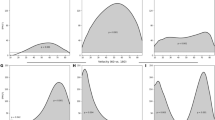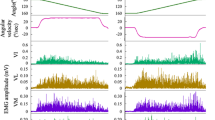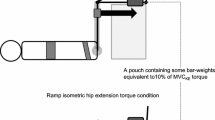Summary
The effect of an increased angle of excursion and isometric pre-activation on isokinetic torques of knee extensors was investigated in five male subjects, mean age 35.0 years, SD 9.6. Peak torque and isoangular torque at 0.52 rad from full knee extension (FKE) were measured when contractions were carried out at 3.14, 4.19 and 5.24 rad·s−1 starting: 1) from a standard knee angle (SA) of 1.57 rad from FKE, 2) from the same starting angle as SA, plus an isometric preload (P) equivalent to 25% of isometric maximal voluntary contraction and 3) from an increased angle of knee flexion (1A), 2.09 rad from FKE plus P. Surface integrated electromyograms (iEMG) of the vastus lateralis muscle in SA and IA+P were also recorded. The IA+P had the effect of increasing peak torque, as compared to SA, on average by 12.0%, SD 7.5% (P<0.001) at 3.14 rad·s−1, 19.5%, SD 5.5% (P<0.001) at 4.19 rad·s−1, 21.6%, SD 10.7% (P<0.001) at 5.24 rad·s−1 and of increasing mean iEMG by 15.7%, SD 7.0% (P<0.001) at 5.24 rad·s−1. The IA+P also had the effect of increasing the angle from FKE at which peak torque occurred: from means of 0.80 rad, SD 0.11 to 1.00 rad, SD 0.07 at 3.14 rad·s−1, from 0.65 rad, SD 0.11 to 0.92 rad, SD 0.09 at 4.19 rad·s−1 and from 0.60 rad, SD 0.11 to 0.88 rad, SD 0.11 at 5.24 rad·s−1 (P<0.0001). Mean isoangular torque rose by 12.6%, SD 5.1% at 5.24 rad·s−1 (P<0.01); mean iEMG values by 8.5%, SD 5.2% (P<0.02) and 11.6%, SD 6.4%(P<0.02) at 4.19 and 5.24 rad·s−1, respectively. The mean time for both peak and isoangular torque development was significantly increased (P<0.0001). The effect of SA+P on peak torque was smaller than that of IA+P, a mean increment of 3.4%, SD 6% (P<0.02) only being observed at 5.24 rad·s−1. The increase in isoangular torque was of the same magnitude as that of IA+P. It was concluded that when isokinetic contractions were carried out from a standard position of the knee at a right angle, neuromuscular activation at high angular velocities (>4.19 rad·s−1) was submaximal. The underestimation of torque seemed to be counteracted by starting the contraction from a flexed position and by utilizing a submaximal P.
Similar content being viewed by others

References
Gransberg L, Knutsson E (1983) Determination of dynamic muscle strength with acceleration controlled Isokinetic movements. Acta Physiol Scand 119:317–320
Hagbarth KE, Kunesch EJ, Nordin M, Schmidt R, Wallin EU (1986) γ loop contributing to maximal voluntary contractions in man. J Physiol 380:575–591
James C (1989) Measurement of power output of the human quadriceps. J Physiol 415:10P
Jewell BR, Wilkie DR (1958) An analysis of the mechanical components in frog's striated muscle. J Physiol 143:515–540
Komi PV (1979) Neuromuscular performance: factors influencing force and speed production. Scand J Sports Sci 1:2–15
Mognoni P, Saibene F, Sant'Ambrogio G, Agostoni E (1968) Dynamics of the maximal contraction of the respiratory muscles. Respir Physiol 4:193–202
Ostering LR (1986) Isokinetic dynamometry: implications for muscle testing and rehabilitation. Exerc Sport Sci Rev 14:45–80
Perrine JJ, Edgerton VR (1979) Muscle force-velocity and power relationship under Isokinetic loading. Med Sci Sports Exerc 10:159–166
Sapega AA, Nicholas JA, Sokolow D, Saraniti A (1982) The nature of the torque overshoot in Cybex Isokinetic dynamometry. Med Sci Sports Exerc 14:368–375
Seger JY, Westing SH, Hanson M, Karlson E, Ekblom B (1988) A new dynamometer measuring concentric and eccentric muscle strength in accelerated, decelerated, or Isokinetic movements. Eur J Appl Physiol 57:526–530
Simonson E, Lind AR (1971) Fatigue in static work. In: Simonson E (ed) Physiology of work capacity and fatigue. Thomas, Springfield, Ill. pp 241–284
Thorstensson A, Oddsson L, Karlson E, Seger J (1986) Does acceleration influence the force-velocity relationship of concentric and eccentric contractions? Med Sci Sports Exerc 18: S63
Wilkie DR (1950) The relationship between force and velocity in human muscle. J Physiol 110:249–280
Winter DA, Wells RP, Orr GW (1981) Errors in the use of Isokinetic dynamometers. Eur J Appl Physiol 46:397–408
Author information
Authors and Affiliations
Rights and permissions
About this article
Cite this article
Narici, M.V., Sirtori, M.D., Mastore, S. et al. The effect of range of motion and isometric pre-activation on isokinetic torques. Europ. J. Appl. Physiol. 62, 216–220 (1991). https://doi.org/10.1007/BF00643745
Accepted:
Issue Date:
DOI: https://doi.org/10.1007/BF00643745



